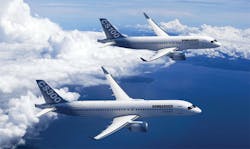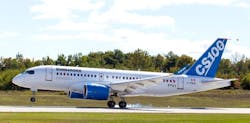Bombardier readies C-Series for avionics testing
Canadian aircraft manufacturer Bombardier is expected to begin testing its second C-Series flight test vehicle in the coming weeks. While the first flight test vehicle was used to evaluate the limitations of the new aircraft, the second test vehicle will be used to evaluate aircraft systems including pressurization, hydraulic, and electrical. A third test vehicle is also expected to lift off in the coming weeks and that aircraft will be dedicated to testing the C-Series avionics systems.
An Ultra-Modern Flight Deck with Double the Screen Space
Officials at Bombardier believe that the subsequent test aircraft will be lifting off at a much quicker pace than the initial first two aircraft. The ultra-modern flight deck of the C-Series is equipped with Rockwell Collins' Pro Line Fusion Avionics and Primary Flight Control Computer. Pro Line Fusion is presently featured on sixteen different aircraft platforms including turbo props, business jets, commercial and military aircraft.
The C-Series features five 15.1-inch LCD displays that enable situational awareness capabilities and comprehensive integration with other aircraft systems including the Rockwell Collins' MultiScan weather radar. The installation of the Rockwell Collins' Primary Flight Control Computer will assist pilots in optimizing fuel efficiency and executing complex aircraft control laws while improving passenger safety and ride comfort. In addition, the avionics suite on the C-Series is expected to provide operators with enhanced operational efficiencies and high dispatch reliability.
The Pro Line Fusion suite also comes with optional Electronic Flight Bags and Heads-Up Displays. These are intended to optimize flight preparations, operations, and completion. The C-Series boasts more than double the amount of screen space found on other aircraft enabling pilots to view multiple pieces of information simultaneously. The two primary flight displays accompanied by two additional inboard displays and a centre console multifunction display have been specially designed to allow the flow of information across multiple screens. At the heart of the improved efficiency is the RNP 0.1 technology that enables the C-Series aircraft to operate precise fly routes, descend continuously, reduce noise and emissions while optimizing flights and approaches. New to Bombardier and the C-Series program will be the use of a sidestick three-axis full fly-by-wire and auto-throttle flight control system. The radio panel is also a showcase of innovation being fully integrated into the glareshield.
Live Aircraft Telemetry: A Game Changer for the Black Box
Another unique innovation of the C-Series is the intent to be the first airliner to provide "live black box" in-flight telemetry data. The concept of live aircraft telemetry did not garner much attention until the tragic crash of Air France flight 447 over the Atlantic Ocean in 2009. The flight data recorder was never found prompting aircraft manufacturers to begin exploring a system that would enable flight data to be transmitted live in a commercially viable way.
Bombardier sees more than just the forensic benefits of a live streaming data system. According to the manufacturer, there are a number of operational benefits including live maintenance diagnostics, the opportunity to leverage data for flight operations and planning, as well as live data for trend analysis and monitoring that will serve as a catalyst for proactive maintenance to reduce the downtime of aircraft. Like the ultra-modern performance capabilities and styling of its C-Series aircraft, Bombardier may be on the verge of another game changer with its live black box concept that will lead the commercial aviation industry in an entirely new direction.
More Than Just Forensic Benefits
The idea is simple in that if stockmarket data can be transmitted directly to a smart phone, aircraft accident analysis and flight operation analysis should not need to rely on reading physical memory chips that often need to be located and rescued from wreckages. Bombardier believes that a variety of ground-based networks including 3G towers, satellite communications, or VHF can be used as conduits for transmission. Bombardier doesn't see their innovation as an improvement on crash investigation but rather a marketable feature of its new C-Series aircraft. The new system will offer airlines the ability to maintain a central database of routine information from standard aircraft operations and performance. Bombardier believes that this unique feature will eventually be installed in all airplanes of the future. If Bombardier is successful in drafting and engineering a perfect system for in-flight telemetry, the technology would also serve a useful purpose by helping to save aircraft in distress. However, the system itself would require the capability of determining when an aircraft is in trouble. The data could then be transmitted to a stand-by pilot working from the ground who could attempt to control the aircraft remotely or communicate instructions to the pilots in command. If the Bombardier C-Series can deliver what its manufacturer claims it is capable of, the aircraft will certainly be a game changer that will become a force to be reckoned with.
Meanwhile, Bombardier continues to prepare their flight test vehicles for on-going flight tests as data is gathered to support its claims. If the C-Series avionics deliver as promised, we can expect to see greater changes and developments coming to the industry in the not too distant future.

